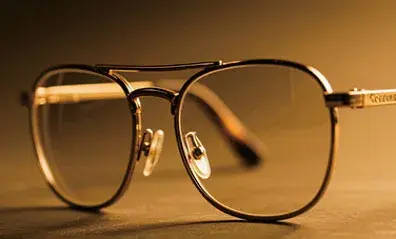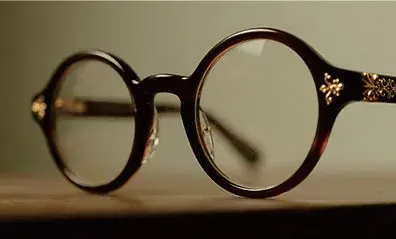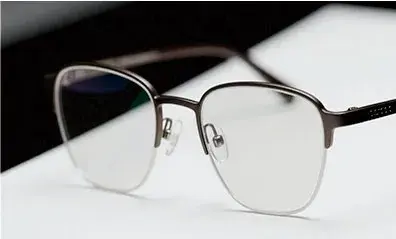The Color Secrets of Functional Eyewear: How the Different Eyeglasses Lenses Affects Visual Experience
The essence of functional eyewear lies in its efficacy, with lens color variations designed to achieve distinct optical functionalities. Blue-light lenses, polarized lenses, and photochromic lenses each leverage unique performance characteristics to protect the eyes while influencing our perception of the color spectrum in different ways.
1.Blue-light lenses
The effectiveness of blue-light lenses primarily lies in countering high-energy short-wavelength blue light emitted by digital screens. Their light yellow or amber tint is not arbitrary but based on spectral filtration functionality, precisely absorbing harmful blue light wavelengths while slightly enhancing the saturation of warm tones, resulting in a softer, warmer visual experience.

This chromatic adjustment mechanism is meticulously calibrated to reduce ocular strain without significantly distorting true color perception, perfectly fulfilling their protective role.
2.Polarized lenses
The utility of polarized lenses focuses on eliminating scattered reflected light. Embedded with a specialized polarizing layer, their dark gray or brown lenses function like microscopic louvers, selectively blocking light waves oscillating in specific orientations.

When encountering intense glare from water, snow, or glass surfaces, their polarization filtering capability suppresses harsh reflections, allowing the natural colors obscured by bright light to appear more vivid and pure. Thus, their color-enhancing property does not directly alter object hues but optimizes lighting conditions to restore visual authenticity.
3.Photochromic lenses
Photochromic lenses demonstrate the most intelligent functionality, relying on light-adaptive molecules for autonomous modulation. Indoors, they remain nearly colorless to maintain standard chromatic perception. Upon UV exposure, the lenses automatically darken to gray or brown, activating dynamic light attenuation comparable to a camera's ND filter, uniformly reducing light transmission.

Although overall brightness decreases, color relationships remain balanced without noticeable distortion. Upon returning to low-light environments, they revert to transparency—an environmental responsiveness that makes them versatile, all-condition lenses.
These lens color differences fundamentally stem from performance-driven material engineering: blue-light lenses utilize dye-based selective wavelength filtration, polarized lenses enhance polarization efficiency through tinting, and photochromic lenses employ light-sensitive compounds for transmittance regulation. Each hue represents a targeted solution to specific visual challenges, transforming eyewear from mere vision correction tools into advanced technological platforms for optimized visual performance.
Functionality and Pricing

1.Blue-Light-Blocking Lenses
- Function: Filters harmful blue light emitted from digital screens (e.g., smartphones, computers) to alleviate eye strain and dryness.
- Application: Indoor office environments, prolonged digital device users.
- Features: Transparent or slightly yellowish tint, maintaining aesthetic appeal for daily wear.
- Common Styles: Business frames, retro round frames (suited for office settings).
- Target Users: Programmers, students, copywriters.

2.Polarized Lenses
- Function: Eliminates reflected glare from surfaces (e.g., water, snow, roads), enhancing visual clarity. Reduces intense light exposure and improves color contrast.
- Application: Driving, skiing, fishing, outdoor sports, and other high-glare scenarios.
- Features: Typically dark-colored (gray/brown/green), unsuitable for low-light conditions.
- Common Styles: Sporty (e.g., aviator), wayfarer (outdoor fashion).
- Target Users: Drivers, anglers, outdoor enthusiasts.

3.Photochromic Lenses
- Function: Automatically adjusts tint intensity based on UV exposure (clear indoors, gray/brown outdoors). Combines vision correction with sunglass functionality.
- Application: Scenarios with frequent indoor-outdoor transitions, such as commuting or traveling.
- Features: Transition speed affected by temperature (slower in cold weather), lifespan ~2-3 years.
- Common Styles: Semi-rimless, full-rim (subtle for daily wear), unsuitable for rimless designs (uneven edge tinting).
- Target Users: Commuters, middle-aged/elderly users with progressive multifocal needs.
Pricing and MOQ
The unit price of blue-light blocking lenses is lower than that of polarized lenses, which in turn is lower than photochromic lenses. This price differential stems primarily from technical cost factors: photochromic lenses require light-sensitive materials such as silver halide with higher technological barriers; polarized lenses necessitate multi-layer polarizing films; while blue-light blocking lenses involve coating processes where reflective coatings are more costly than absorptive ones. Brand premium also significantly impacts pricing, with imported brands commanding substantially higher prices than domestic products, making OEM production a viable alternative for some buyers. Furthermore, consumers' demand for convenience and comprehensive protection often leads to additional functionalities being incorporated, such as UV400 protection for photochromic lenses or impact-resistant coatings for polarized lenses. These value-added features increase production costs and influence minimum order quantities, consequently affecting price variations. Notably, higher order volumes enable the amortization of production line setup costs across more units, thereby reducing the per-unit price.
Custom Lens Guide
The lens customization process begins with submitting optical prescriptions (sphere/cylinder/axis/PD) and selecting features (blue-light/polarized/photochromic). Factories then verify material compatibility (1.56-1.74 index) and coating feasibility (16-layer max).
Contracts define order tiers (500/1000/5000 units) ,Different minimum order quantities have different starting prices,and defect policies (<3%). Precision cutting (0.01mm) and coating (80±5°C) ensure quality, validated through power verification (±0.03D) and UV testing.
Special shipping protects photochromic (light-proof) and polarized (anti-static) lenses. Post-production support includes certifications (FDA/CE) and solutions for fogging (nano-coating) or delamination (cleaning process review).

Functional eyewear—blue-light, polarized, and photochromic lenses—varies in price based on technical demands. Blue-light lenses filter HEV light for digital users, offering affordable protection via simple coatings. Polarized lenses block glare using precision optical films, making them mid-priced and ideal for outdoor use, with bulk discounts available. Photochromic lenses, the costliest, adapt to light via embedded compounds, requiring complex manufacturing but benefiting from scale economies. Each enhances visual comfort: blue-light for screens, polarized for glare, and photochromic for light adaptation. Pricing reflects functionality—basic to advanced—guiding buyers to align needs with budget. Bulk orders reduce costs, particularly for high-tech options. Choose based on usage: digital, outdoor, or variable lighting.